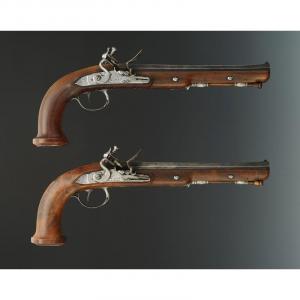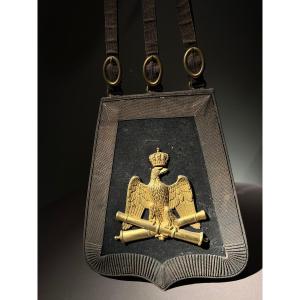A bomb made of "yellow copper" brass according to regulations, made in one piece stamped at the balance and finished with a hammer. Four suction holes are drilled in the bomb. The back of the bomb is dated 1873 "73", marked "750", assigned to the 7th regiment "7D". Turban in two pieces of half-tanned cowhide, assembled in front and back by a cross-stitched seam. The turban is attached to the bomb using four flat-headed rivets, with counter-rivet washers, that go through both pieces. Brass visor, edged with a strip of copper running along the outer edge. This circle (H on each side 8 mm) is attached to the visor by a red copper rivet at each end. It is lined underneath with a green basane glued and caught in the edge setting of the border circle. Visor width at its center 5.5 cm. Neck guard in brass circled in copper similar to the visor, lined in glued black basane. Headband in navy cowhide, dyed in a tan color and speckled in black, to imitate tiger skin (this overall tan dye before the speckling is essential, not only for a more complete imitation of the fur); it is cut to fit precisely under the molding of the bomb, extending over the visor and the neck guard, leaving only about a quarter of both visible. At each end, the headband is lined on the inside with a small copper blade pierced with four holes with metal eyelets. On each side, two washers, one lower, one outer, pierced in the center and connected by a metal eyelet, are fitted where the strap studs pass through. Two straps, each made up of fourteen flat rings covered in leather, assembled in chain mail, decreasing in size. These rings are mounted with a fine brass wire, with the ends sunk under the leather, on a core of strong black varnished leather, finished with a black varnished calf reverse buckle and a buckle with a bar carrying a barb. The two upper rings of the chain, which only present part of their circumference, merge with a copper rosette 5.3 cm in diameter, bordered with a plain ring with 16 laurel leaves arranged in rays around a hole in the center. Each strap is attached to the helmet by a copper screw with a hemispherical head. Crest placed on the bomb, from front to back; it is made of yellow copper and consists of two fins, a mask, and a cover. The concave-based fins form a scalloped edge pierced with two holes for copper screws, with round teardrop heads, stopped inside the bomb by nuts. They are adorned with palmettes and a garland on their upper edge. The edge is decorated with water leaves, all embossed. The mask acts as the front junction between the two fins. It is embossed with a heavily relief head of Medusa, topped with a small oak crown and at the bottom, above the lamp base of the mask, is a low-relief grenade. Copper screw at the base of the lamp base. The copper cover is embossed with a low-relief braid. The crest decoration includes a lower socket, a lens adorned with embossed palmettes, and an upper socket, also adorned with palmettes. Black horsehair brush. Black dyed horsehair mane, approximately 45 cm long. Brass plume-holder decorated with foliage branches. Interior lining composed of a strong black basane cap, cut in a wolf's tooth pattern, with metal eyelets on the tips of the teeth.
France.
Second Empire.
Very good exterior condition, never cleaned, poor condition interior cap with missing wolf's teeth
NOTE:
This piece is part of the last 1858 helmets delivered in 1873, as the following year the new 1874 model would be distributed.
HISTORY:
The 7th Dragoons received their new standard on 10/5/1852. On 11/4/1854, they participated in a review in honor of the Duke of Cambridge and Lord Raglan, the future commander of the British army in the East. It was a few days later that the 7th Dragoons were designated to be part of the French expeditionary force in the East. Four squadrons left Marseille in June 1854 on small merchant sailboats and landed in Gallipoli in mid-July. Quickly hit by cholera, the regiment moved to Adrianople on 3/11/1854, but the end of the Dobrudja expedition required their return to Constantinople where they spent the winter. Sent to the Crimea, the 7th Dragoons landed at Kamiesh, the French army's supply base, at the end of April 1855, and were brigaded with the 6th Dragoons. Their first engagement took place on May 24 during the battle of the Tchernaïa, and the regiment contributed to the capture of the Russian battery "Bilboquet." During the summer of 1855, they carried out several reconnaissance missions, foraging, and outpost services. After the capture of Sevastopol, the 7th Dragoons were sent to Eupatoria. It was during this expedition that they were engaged at Kanghill on 29/9/1855, and along with the 6th Dragoons, they rescued the 4th Hussars who had first charged the Russian Cossacks. Their return to France occurred in May 1856. In 1870, the regiment was brigaded in the cavalry division of the 2nd Army Corps (General Frossard). They participated in the battles of Sarrebruck (2/8/1870) and Forbach (6/8/1870) before regrouping in Metz. On 16/8/1870, at Rezonville, the 7th Dragoons were engaged against Bredow's division (known as the "charge of death"). After the siege of Metz, the regiment surrendered with the army on 29/10/1870. Reconstituted in Valenciennes, the 7th Dragoons were sent to Paris on 10/4/1871 to contribute to the blockade of Paris during the Commune. Under the Republic, the 7th Dragoons were not engaged in active operations before 1914.









































 Le Magazine de PROANTIC
Le Magazine de PROANTIC TRÉSORS Magazine
TRÉSORS Magazine Rivista Artiquariato
Rivista Artiquariato